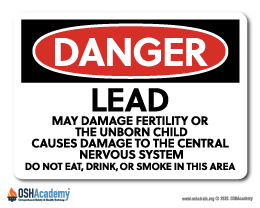Warnings
Warnings do help to raise awareness about entering hazardous lead-containing areas, but they do not prevent entry.
Warnings work only as long as employees comply with them. Generally, warnings include signs, alarms, and labels. Employers are required to post this warning sign where the PEL of lead is exceeded.
All signs must be well lit and kept clean so that they are easily visible. Statements that contradict or detract from the signs' meaning are prohibited. Signs required by other statutes, regulations, or ordinances, however, may be posted in addition to, or in combination with, this sign.
Work Practice Controls
A rigorous housekeeping program and the observance of basic personal hygiene practices will minimize employee exposure to lead. These two elements of the worker protection program help prevent workers from taking lead-contaminated dust out of the worksite and into their homes where it can extend the workers' exposures and potentially affect their families' health.
Change Areas
The employer must provide a clean change area for employees whose airborne exposure to lead is above the PEL.
- The area must be equipped with storage facilities for street clothes and a separate area with facilities for the removal and storage of lead-contaminated protective work clothing and equipment. This separation prevents cross-contamination of the employee's street and work clothing.
- Employees must use a clean change area for taking off street clothes, suiting up in clean protective work clothing, donning respirators before beginning work, and dressing in street clothes after work. No lead-contaminated items should enter this area.
- Work clothing must not be worn away from the jobsite. Under no circumstances should lead-contaminated work clothes be laundered at home or taken from the worksite, except to be laundered professionally or for disposal following applicable federal, state, and local regulations.
Showers
When feasible, showers must be provided for use by employees whose airborne exposure to lead is above the permissible exposure limit so they can shower before leaving the worksite.
- Where showers are provided, employees must change out of their work clothes and shower before changing into their street clothes and leaving the worksite.
- If employees do not change into clean clothing before leaving the worksite, they may contaminate their homes and automobiles with lead dust, extending their exposure and exposing other members of their household to lead.
Washing Facilities
In addition, employers must provide adequate washing facilities for their workers.
- These facilities must be close to the worksite and furnished with water, soap, and clean towels so employees can remove lead contamination from their skin.
- Contaminated water from washing facilities and showers must be disposed of in accordance with applicable local, state, or federal regulations.
Housekeeping Practices
An effective housekeeping program involves a regular schedule to remove accumulations of lead dust and lead-containing debris.
- The schedule should be adapted to exposure conditions at a particular worksite. OSHA's Lead Standard for Construction requires employers to maintain all surfaces as free of lead contamination as practicable.
- Vacuuming lead dust with HEPA-filtered equipment or wetting the dust with water before sweeping are effective control measures.
- Compressed air may not be used to remove lead from contaminated surfaces unless a ventilation system is in place to capture the dust generated by the compressed air.
- Put all lead-containing debris and contaminated items accumulated for disposal into sealed, impermeable bags or other closed impermeable containers.
- Label bags and containers as lead-containing waste. These measures provide additional help in controlling exposure.
End-of-Day Procedures
Employers must ensure that workers who are exposed to lead above the permissible exposure limit follow these procedures at the end of their workday:
- Place contaminated clothes, including work shoes and personal protective equipment to be cleaned, laundered, or disposed of, in a properly labeled closed container.
- Take a shower and wash their hair. Where showers are not provided, employees must wash their hands and face at the end of the workshift.
- Change into street clothes in clean change areas.
Personal Hygiene Practices
Emphasize workers' personal hygiene such as washing their hands and face after work and before eating to minimize their exposure to lead. Provide and ensure that workers use washing facilities. Provide clean change areas and readily accessible eating areas. If possible, provide a parking area where cars will not be contaminated with lead. These measures:
- Reduce workers' exposure to lead and the likelihood that they will ingest lead,
- Ensure that the exposure does not extend beyond the worksite,
- Reduce the movement of lead from the worksite, and
- Provide added protection to employees and their families.
Personal Practices
The employer must ensure that employees use suitable personal hygiene practices to prevent exposure to lead.
- Do not enter lunchroom facilities or eating areas with protective work clothing or equipment unless surface lead dust has been removed. HEPA vacuuming and use of a downdraft booth are examples of cleaning methods that limit the dispersion of lead dust from contaminated work clothing.
- In all areas where employees are exposed to lead above the PEL, employees must observe the prohibition on the presence and consumption or use of food, beverages, tobacco products, and cosmetics. Employees whose airborne exposure to lead is above the PEL must wash their hands and face before eating, drinking, smoking, or applying cosmetics.
Knowledge Check Choose the best answer for the question.
2-4. To be effective, lead warning signs must rely on _____.
You forgot to answer the question!

